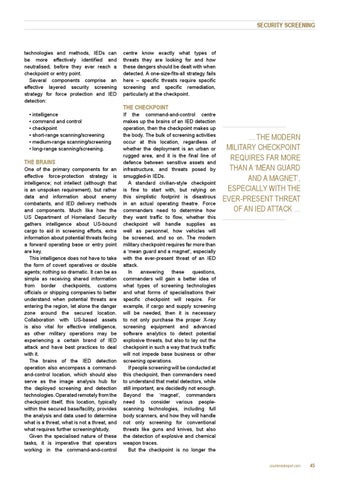SECURITY SCREENING
technologies and methods, IEDs can be more effectively identified and neutralised, before they ever reach a checkpoint or entry point. Several components comprise an effective layered security screening strategy for force protection and IED detection:
centre know exactly what types of threats they are looking for and how these dangers should be dealt with when detected. A one-size-fits-all strategy fails here – specific threats require specific screening and specific remediation, particularly at the checkpoint.
• intelligence • command and control • checkpoint • short-range scanning/screening • medium-range scanning/screening • long-range scanning/screening.
If the command-and-control centre makes up the brains of an IED detection operation, then the checkpoint makes up the body. The bulk of screening activities occur at this location, regardless of whether the deployment is an urban or rugged area, and it is the final line of defence between sensitive assets and infrastructure, and threats posed by smuggled-in IEDs. A standard civilian-style checkpoint is fine to start with, but relying on this simplistic footprint is disastrous in an actual operating theatre. Force commanders need to determine how they want traffic to flow, whether this checkpoint will handle supplies as well as personnel, how vehicles will be screened, and so on. The modern military checkpoint requires far more than a ‘mean guard and a magnet’, especially with the ever-present threat of an IED attack. In answering these questions, commanders will gain a better idea of what types of screening technologies and what forms of specialisations their specific checkpoint will require. For example, if cargo and supply screening will be needed, then it is necessary to not only purchase the proper X-ray screening equipment and advanced software analytics to detect potential explosive threats, but also to lay out the checkpoint in such a way that truck traffic will not impede base business or other screening operations. If people screening will be conducted at this checkpoint, then commanders need to understand that metal detectors, while still important, are decidedly not enough. Beyond the ‘magnet’, commanders need to consider various peoplescanning technologies, including full body scanners, and how they will handle not only screening for conventional threats like guns and knives, but also the detection of explosive and chemical weapon traces. But the checkpoint is no longer the
THE BRAINS
One of the primary components for an effective force-protection strategy is intelligence; not intellect (although that is an unspoken requirement), but rather data and information about enemy combatants, and IED delivery methods and components. Much like how the US Department of Homeland Security gathers intelligence about US-bound cargo to aid in screening efforts, extra information about potential threats facing a forward operating base or entry point are key. This intelligence does not have to take the form of covert operatives or double agents; nothing so dramatic. It can be as simple as receiving shared information from border checkpoints, customs officials or shipping companies to better understand when potential threats are entering the region, let alone the danger zone around the secured location. Collaboration with US-based assets is also vital for effective intelligence, as other military operations may be experiencing a certain brand of IED attack and have best practices to deal with it. The brains of the IED detection operation also encompass a commandand-control location, which should also serve as the image analysis hub for the deployed screening and detection technologies. Operated remotely from the checkpoint itself, this location, typically within the secured base/facility, provides the analysis and data used to determine what is a threat, what is not a threat, and what requires further screening/study. Given the specialised nature of these tasks, it is imperative that operators working in the command-and-control
THE CHECKPOINT
... THE MODERN MILITARY CHECKPOINT REQUIRES FAR MORE THAN A ‘MEAN GUARD AND A MAGNET’, ESPECIALLY WITH THE EVER-PRESENT THREAT OF AN IED ATTACK …
counteriedreport.com
45
